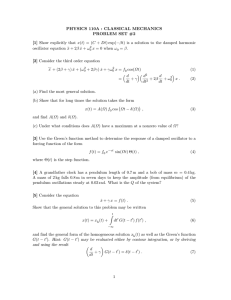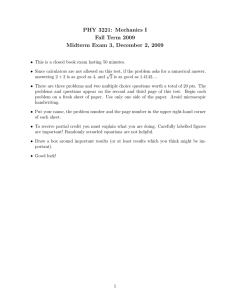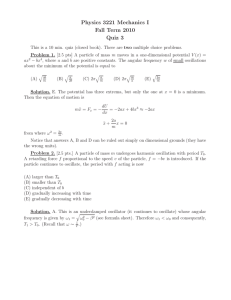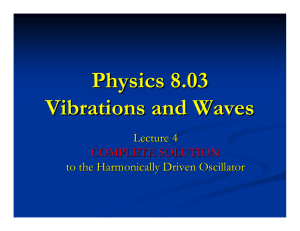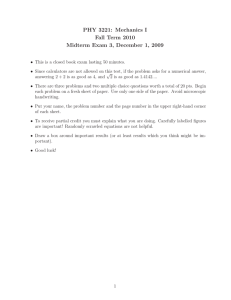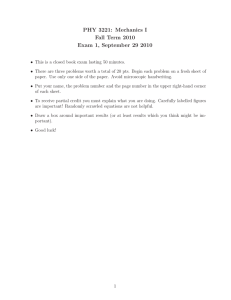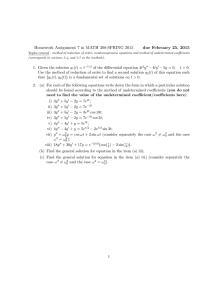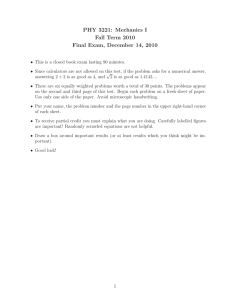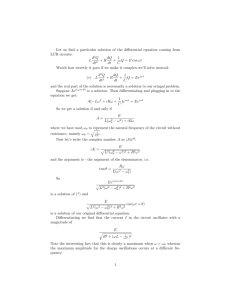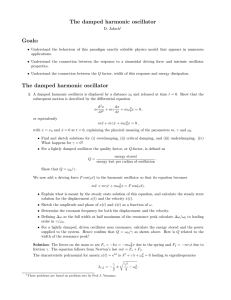PHY 3221: Mechanics I Fall Term 2009 Final Exam, December 16, 2009
advertisement
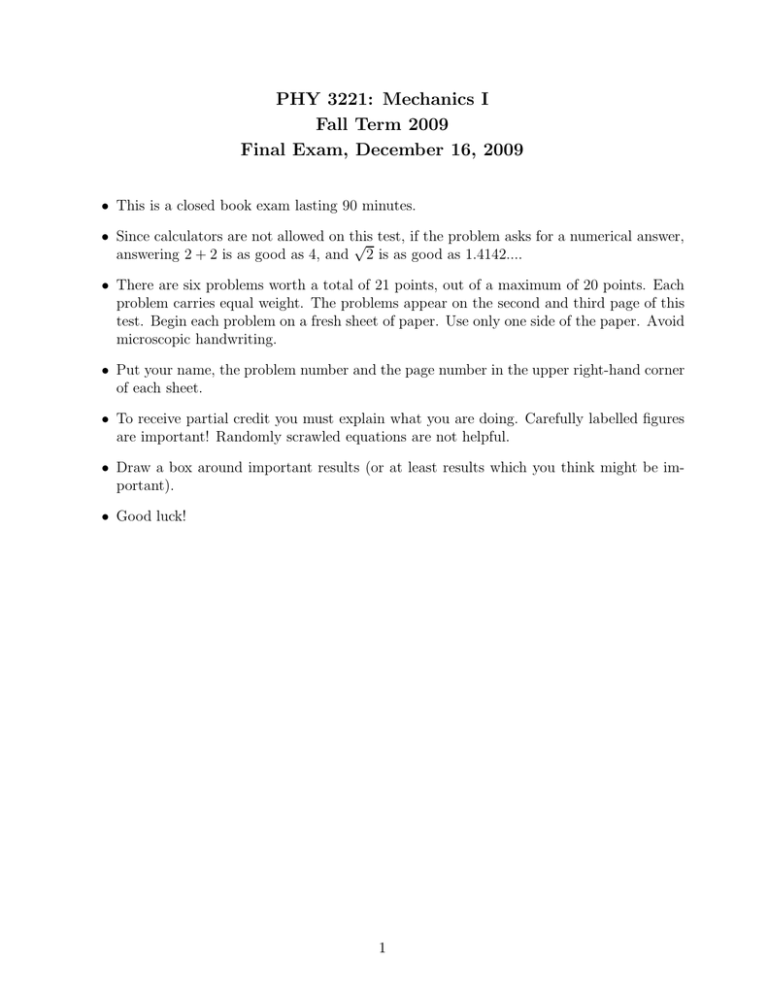
PHY 3221: Mechanics I Fall Term 2009 Final Exam, December 16, 2009 • This is a closed book exam lasting 90 minutes. • Since calculators are not allowed on this √ test, if the problem asks for a numerical answer, answering 2 + 2 is as good as 4, and 2 is as good as 1.4142.... • There are six problems worth a total of 21 points, out of a maximum of 20 points. Each problem carries equal weight. The problems appear on the second and third page of this test. Begin each problem on a fresh sheet of paper. Use only one side of the paper. Avoid microscopic handwriting. • Put your name, the problem number and the page number in the upper right-hand corner of each sheet. • To receive partial credit you must explain what you are doing. Carefully labelled figures are important! Randomly scrawled equations are not helpful. • Draw a box around important results (or at least results which you think might be important). • Good luck! 1 Problem 1. [3.5 pts] In Cartesian coordinates, some force is given by F~ = k(y, x, 0), where k is a constant. Is this a conservative force? If the answer is “yes”, find the corresponding potential energy U (x, y, z). Problem 2. [3.5 pts] Refer to Fig. 1. A clumsy skateboarder lets her skateboard roll down a frictionless “quarter pipe” ramp, which has the profile of a cylinder of radius R. Assume that the skateboard started rolling from rest at point A, which is a distance H above the ground, and landed at point B, which is a distance D from the end of the ramp. Find D in terms of H, R and g. A R ~g H B D Figure 1: An illustration for the skateboarder problem. Problem 3. [3.5 pts] A particle starting at rest is attracted to a force center according to the relation F = −mk 2 /x3 . Show that the time required for the particle to reach the force center from a distance L is L2 /k. 2 Problem 4. [3.5 pts.] The natural frequency of a critically damped oscillator is ω0 . Initially, at time t = 0, the oscillator is displaced a distance L from its equilibrium position and then released. Find the velocity v of the oscillator at a later time t. Problem 5. [3.5 pts.] Refer to Fig. 2. A hole has been drilled straight through the center of a spherical planet of mass M and radius R. Assume uniform mass density and neglect rotational effects and friction. (a) A stone of mass m has been dropped in the hole at point A. Find the time it takes to arrive at point B. Hint: show that the stone’s motion in the hole is simple harmonic and find its frequency. (b) Now suppose the stone is launched into a circular orbit just above the surface of the planet. How long does it take to reach point B in this case? A R M B Figure 2: An illustration for the supertunnel problem. Problem 6. [3.5 pts.] A point mass m is located a distance D from the nearest end of a thin rod of mass M and length L, along the axis of the rod. Find the gravitational force exerted on the point mass by the rod. 3 Formula sheet A·(B × C) = B·(C × A) = C·(A × B) ≡ ABC A×(B × C) = (A · C)B − (A · B)C (A × B) · (C × D) = A · [B × (C × D)] = A · [(B · D)C − (B · C)D] = (A · C)(B · D) − (A · D)(B · C) (A × B) × (C × D) = [(A × B) · D] C − [(A × B) · C] D = (ABD)C − (ABC)D = (ACD)B − (BCD)A v = ṙ er + r θ̇ eθ + r sin θ φ̇ eφ a = + 2ṙ φ̇ sin θ + 2r θ̇φ̇ cos θ + r θ̈ sin θ eφ v = ṙ er + r φ̇ eφ + ż ez a = r̈ − r θ̇ 2 − r φ̇2 sin2 θ er + 2ṙ θ̇ + r θ̈ − r φ̇2 sin θ cos θ eθ r̈ − r φ̇2 er + r φ̈ + 2ṙ φ̇ eφ + z̈ ez X εijk εlmk = δil δjm − δim δjl k X εijk εljk = 2 δil j,k X εijk εijk = 6 i,j,k Time averages over one period T : 1 hsin ωti = T 2 hcos2 ωti = Tidal force Z t+T dt sin2 ωt = t 1 Z t+T 1 dt cos2 ωt = T t 2 2GmMm r cos θ D3 GmMm r sin θ = − D3 FT x = FT y 1 2 Rocket motion Fext = mv̇ + uṁ 4 Simple harmonic oscillator: mẍ + kx = 0 x(t) = A sin(ω0 t − δ) x(t) = A cos(ω0 t − φ) s 2π = ω0 = 2πν0 = τ0 Damped oscillator: k m b ẍ + 2β ẋ + ω02 x = 0, 2β = m √ 2 2 √ 2 2 x(t) = e−βt A1 e β −ω0 t + A2 e− β −ω0 t Underdamped motion x(t) = Ae−βt cos(ω1 t − δ), ω1 = q ω02 − β 2 Critically damped motion x(t) = (A + Bt)e−βt Overdamped motion h i x(t) = e−βt A1 eω2 t + A2 e−ω2 t , Driven oscillator ω2 = q F0 ẍ + 2β ẋ + ω02 x = A cos ωt, A = m √ 2 2 √ 2 2 xc (t) = e−βt A1 e β −ω0 t + A2 e− β −ω0 t xp (t) = q A (ω02 − ω 2 )2 + 4ω 2 β 2 δ = tan −1 q 2ωβ 2 ω0 − ω 2 cos(ωt − δ) ! ω02 − 2β 2 ωR Q= 2β ωR = RLC circuit VL = L Gauss’s law β 2 − ω02 Z S dI dt VR = RI ~n · ~g da = −4πG 5 VC = Z V ρ dv q C
